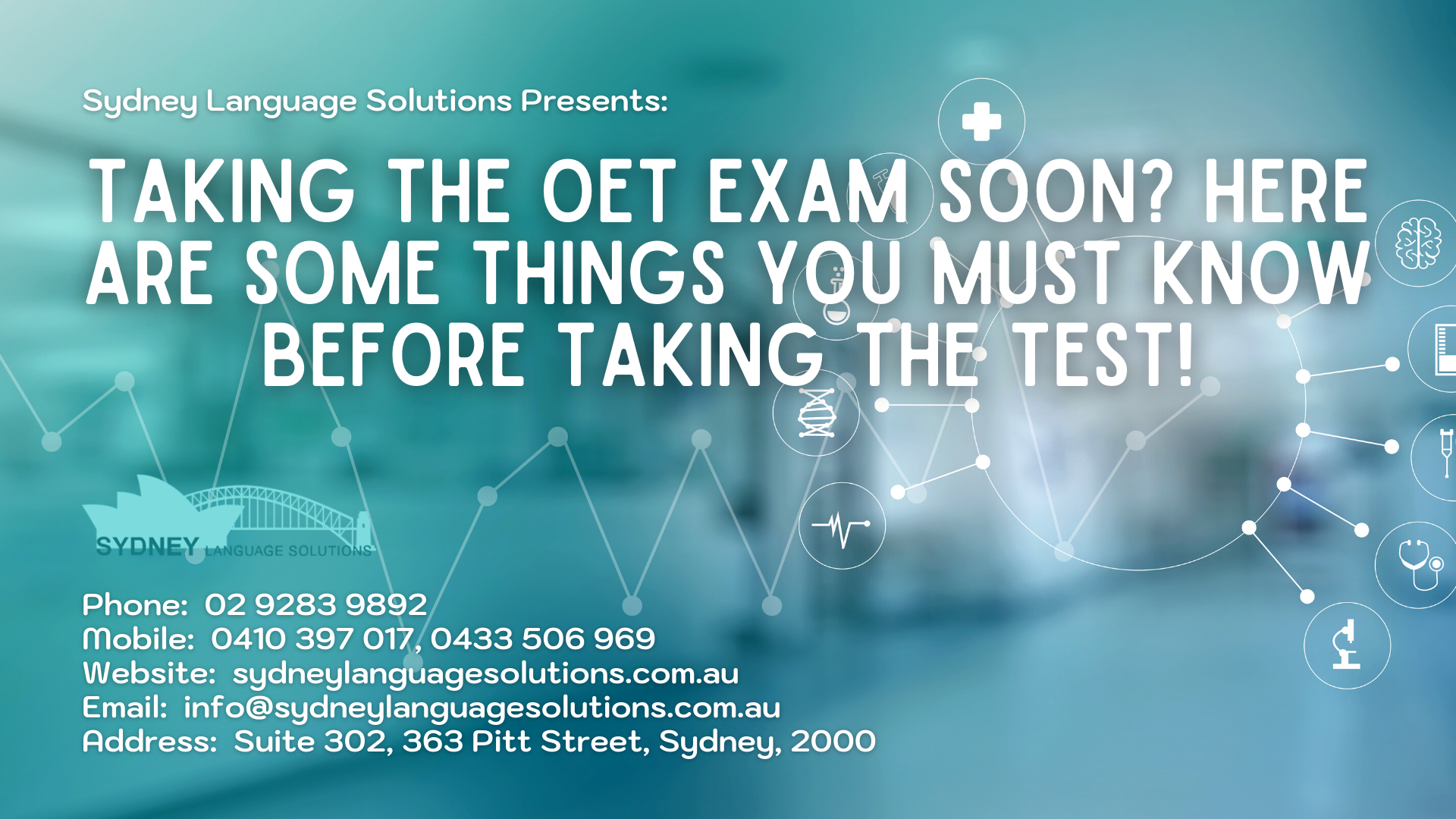Things You Must Know Before Taking Your OET Exam
Things that you should know before taking OET test
1. No matter what your English level is, the sooner you prepare, the better. OET is a high-stakes English test in which organisation will use it to evaluate its future employees. Such employees are responsible for the safety of patients.
2. You must be aware of OET test structure and how it will be marked. The OET comprises four sub tests, which are graded from A to E (where A is the highest and E is the lowest). Test structure:
- Listening (approximately 50 minutes)
- Reading (60 minutes)
- Writing (45 minutes)
- Speaking (approximately 20 minutes)
3. Check out the minimum marks for the acceptance of your school or your visa, then set the goals that you need and want to achieve. Although the goals are motivation for your study, you need also be realistic about your ability and the goals.
4.OET tests both your English and knowledge of healthcare terms, especially your occupation-related topics. Understanding the most commonly used and more complex terms is the key for your achievement in OET.
5.Practice tests help you familiar with test format, understand your weaknesses and strengths and get yourself ready for the real exam. You can check your Reading and Listening with answer keys but If you have friends whose English is proficient, ask for feedback on your Writing and Speaking.
6.You might feel alone and struggle with OET preparation time, let SLS stand by you. Our experienced trainers with updated materials will give you a higher chance of success on test day.
More Tips on How to Achieve a High OET Mark
- Learn about the test overview and structure: this involves fully understanding each section of the exam and what it is assessing. If you know what to expect on the test, you can go into test day able to focus on the questions and task themselves.
- Create a study plan: Look at how many days you have until you take OET, what your goals are and how much time you will realistically be able to dedicate to revising every day and then create a study plan.
- Sharpen your skills: If you like working in a group, enroll in a preparation course from a certified preparation provider. If you prefer to prepare on your own, find an online course or preparation book that will provide you with exercises and key strategies for correctly answering each part of OET.
- Take practice tests: take multiple sample tests throughout your preparation. Not only will it familiarize yourself with the OET, but it will also give you ideas of your strong areas and where you need to improve.
- Review everything: Go over the test overview again to review the key strategies. It’s also a good time to practice those sections of the test where your performance is weakest. Recheck your OET application to make sure everything is in order and contact the OET help desk if there are any problems.
- Let our experienced OET trainers help you! Sydney Language Solutions offers ONLINE CLASSES!
Tips on How to Achieve a High OET Mark
- Active listening skills during the speaking test: this involves carefully listening to the interlocutor and fully understanding the scenario presented to you.
- Empathy and reassurance during the speaking test: instead of just focusing on what to say next, it is important to first listen to the interlocutor and reassure them in order to avoid skipping directly to another topic.
- Stay within the word limit in the writing section: many students either write too much or too little information related to the case. Your writing can go a little below or above the word limit but try not to have a drastic difference in the size of your writing piece.
- Take mock exams: mock exams are a great way to familiarize yourself with the pattern of the exam and also to identify areas lacking practice and improve in them accordingly.
- Listen to podcasts and youtube videos to help with the listening section: playing podcasts and youtube videos while exercising on travelling on the train/bus can help you improve your listening skills.
- Time management: prioritizing your time in the right way across the different sections of the exam will ensure that nothing is left out and you are able to complete all parts of the exam on time.
5 Tips on How to Reduce Your Accent to Sound Like a Native Speaker
Having an accent is not a bad thing; one should not be ashamed of it. A person’s accent represents his or her background and culture. Lots of people take pride in their accent as it reveals their cultural heritage. Even English native speakers have their own accents such as American-English, British-English or Australian-English. However, this sometimes causes difficulty in understanding so some people are embarrassed by their own accent in English Speaking. It turns out that having a residual accent might affect self-confidence in communication and interaction.
There are some techniques that non-native English speakers can use to reduce their accent in speaking.
- Slow down and clearly pronounce words
People tend to speak fast when they are excited or nervous. If you have an accent, try to speak slowly and clearly pronounce words so that everyone can understand what you want to say.
- Feel the rhythm while speaking English
English is considered “stressed language” as every single word have its own stress, differently on verbs, words and adjectives. Same to sentence. People said that sentence stress gives English a rhythm or beat.
- Listen and Talk to native speakers
Listen and repeat to sentences spoken by native speakers until you can naturally speak those sentences. Try to speak to the native speakers as many as possible. You need to overcome your in-confidence and speak to the native speakers. It might make you feel embarrassed at first but failure creates success. People also tend to imitate others whom they frequently interact with. Therefore, the more you talk to the native speakers, the more you could improve.
- Record yourself
Don’t learn from others only, learn from yourself. Take your time to record your speaking and listen again to identify your weaknesses. Recording will also make you proud of yourself in how clarity in your pronunciation has progressed.
- Take a class or tutor
Consider working with an experienced tutor or teacher to help you with pronunciation, intonation and even vocabulary. An ESL teacher will have his/her strategy to quickly help you with your accent. Joining a class might also motivate you as you have partners in your accent reduction journey.
English Pronunciation: Compound Adjectives
A compound adjective is a fixed expression which is made up of more than one word and which has the function of an adjective. Most compound adjectives are written with a hyphen, but a few are written as one word:
skin-deep long-term threadbare
The following types of compound adjective usually have main stress on the first part:
- compound adjectives usually written as one word
- ‘ airtight ‘ carefree ‘ praise , worthy
- Exceptions: , nation ‘ wide, , hand ‘ made
- noun + -ing form
- ‘ hair- , raising ‘ fee- , paying ‘ time-con,suming
- noun + past participle
- ‘ poverty- , stricken ‘ pear-shaped ‘ health-re,lated
- Exceptions: , eagle- ‘ eyed, , home- ‘ grown
The following types of compound adjective usually have main stress on the second part:
- noun + adjective
- , fat- ‘ free , sky- ‘ high , snow- ‘ white
- Exception: ‘ camera-shy
- adjective + noun
- , long – ‘ term , full – ‘ length , high – ‘ profile
- adverb or adjective + past participle
- , fully- ‘ grown , long- ‘ sighted , well – ‘ dressed
- adverb or adjective + -ing form
- , easy- ‘ going , hard – ‘ working , well – ‘ meaning
- Exceptions: ‘ backward – , look ing, ‘ forward- , looking
- self- as the first part
- , self- ‘ confident , self-in ‘ flicted , self- ‘ governing
Most compound adjectives with main stress on the second part can have stress shift. Compare:
- The tiger was fully-GROWN. but: It was a FULly-grown TIger.
- The prices were sky-HIGH. but: They were SKY-high PRIces.
5 Reasons Why Good English is Essential in Business!
English is the language of communication: English is the most widely spoken language in the world with over 1 billion people using it as a foreign language.
English spoken in business is different from English spoken in daily lives, as certain industries have certain vocabulary or jargon. For example, English vocabulary is different in business administration, finance, law or retail.
Mastery of English is beneficial even though you are working in your home country. Many businesses are international in scope and English is official language in the company.
Better job opportunities: if you work in English-speaking countries, English is a must. In non-English-speaking countries, it would be another skill that you can add to your resume and would boost your chances of job promotion.
More confidence in working: Business English with Sydney Language Solutions will improve your confidence in presentation, negotiation, conversation, better comprehension and pronunciation in Business context. All of these will boost your confidence in conducting Business in English.
OET Reading
OET Reading Tips: Part A
Part A is a time-dependent section of the reading that requires important skills of skimming and scanning texts in order to locate specific information. Here are some tips that will help you to do well on the reading Part A:
- When you’re first given the test, spend the first 30-60 seconds skim reading the 4 texts.
- Read the headings and look for key words quickly to get a basic understand of what information is located in each of the texts, before you read the questions. This will help you locate the information quickly.
- When you read a question, ask yourself “which text is most likely to contain this information?” Skim over the suspected text(s) to see if you can find the specific information you are looking for and use this to answer the question.
- If you cannot find the information, try again with a different text.
- At no point should you be reading through long sections of text, or taking time to comprehend or interpret the information. This section requires word recognition.
- Answer the questions using the wording in the text; however pay careful attention to the wording of the question to ensure that you have provided the most accurate answer.
OET Reading Tips: Part B
Part B involves six texts, with a single multiple-choice question for each. In order to do well with part B, it is important that you read and understand the contextual information, the question, and all of the options thoroughly before you turn to the text. Once you have read and understood the text, turn back to the question and select the most accurate answer. Do not select the answer that uses similar wording as in the text, unless you are sure it is correct, as often this is not. Pay careful attention to the question and make sure your selection truly answers the question. Sometimes one of the options may be correct when compared with the text, however, it may not fit the question. If you are unsure of the vocabulary, use the surroundings words to help approximate the meaning.
OET Reading Tips: Part C
Often people are overwhelmed by the amount of content in each of the extracts. Don’t be, as you will only need to be able to understand and interpret one paragraph per multiple-choice question. As with part B, it is important to read the first question and the options, and ensure that you fully understand them before you read the first paragraph. Attempt to understand it as best as you can before turning back to the question and selecting the correct answer. If you are spending longer than 2 minutes on a question, move on, and you can go back and attempt it later if you have time. Part C requires you to understand the author’s opinion and views. Like in the listening test, avoid bringing your own understanding to the test. If you are asked to define a word or short phrase, do not worry if you aren’t sure what it means. Try to deduce this from the context in which it is used. You should not use your own definition, as it may not be true in the context of the extract.
When you are doing Reading in OET, always follow these tips above.
OET Listening
OET Listening Tips: Part A
Part A requires you to identify specific information during a consultation between a health-care professional and a patient. Here is a list of tips and tricks to help you pass the listening test:
- Use the same words that you hear on the recording, and avoid paraphrasing or changing anything.
- Give the most accurate answer possible, such as any descriptive words, provided your answer is 3 words or less (e.g. ‘bowel cancer’ not just ‘cancer’).
- Use the subheadings to guide you through the case notes, and help if you get lost (e.g. presenting complaint, family history, medications, plan etc.).
- Use abbreviations that are accepted by all Tramadol best health care professionals, but if unsure write it out in full to be safe.
- Don’t worry if you don’t find an answer- just move on, otherwise you will miss important information to answer subsequent questions.
- Your job is to copy down the words that you hear in order to fill out the case notes- there is no need to interpret or comprehend the information given.
- Check for errors at the end when you have time to read over your answers, and fill in the gaps.
- They don’t mark spelling, so if you are unsure spell the word phonetically and you will get the mark.
OET Listening : Part B
Part B involves listening to six short workplace extracts of about 1 minute each. Important things to identify in each extract involve detail, gist, opinion, or purpose. In order to do well you must do the following:
- Make sure you read the question, and really understand what they are asking.
- Read the MCQ options before you hear the audio, and understand each option- the wording can be tricky, so be very careful.
- Don’t go for most complicated answer, or the answer that uses the same wording as the audio if you are unsure. Often these options are not correct.
- Once you have read the question and options in full and have understood what is being asked, give the audio your complete attention so that you can select the most accurate answer.
OET Listening : Part C
Part C involves following a recorded presentation or interview, which will cover a range of healthcare topics. You will be required to:
- Stay focused and attentive, so that you can listen and understand as much of the audio as possible.
- Read the question and all the options thoroughly before you answer, as there may be more than one correct option. You must select the option that is the most correctly fits the question.
- Don’t apply your own understanding of the topic when deciding which answer to select, as this may not be the same understanding as that of the speaker.
- Listen carefully to learn the beliefs, opinions and perceptions of the person who is speaking. Use these to answer the questions.
- Stay on top of the questions by listening for key words that will help to guide you through.
- If you miss a question just move on. You can come back to it in the 2 minutes reading time at the end and guess the answer.
When you are doing Listening in OET, always follow these tips above.
Reading A – 3 common trick questions
In this post we will talk about three reasonably common trick questions in Reading A that aim to find the best students. It is very easy to lose marks on these questions when you are rushing because they are very sneaky, but being aware of them can increase your chance of getting them correct.
1. Plural and singular
Text: “Screening mammograms are the best method for detecting breast cancer in the early stages”
Question: “The best method for detecting breast cancer in the early stages is …..?…..”
The text and the question sentences almost look identical, although obviously the order of information has changed. The other thing that has changed is that where the text used the plural verb “are” the answer has the singular verb “is”; therefore, we need to change the words “screening mammograms”, which is plural, into a singular form – the answer is “a screening mammogram”
2. Splitting up acronyms
Text: “25% of Australian adults are obese, with a body mass index (BMI) of 30 or higher”
Question: “Obesity is defined as a …..?….. index of greater or equal to 30”
The answer is obviously to do with body mass index, and as they have used the abbreviation BMI in the text we are allowed to use this for our answer. However, note that the question already has the word “index” written down, so writing “BMI” will be marked wrong, because you are saying “body mass index index”. The answer is therefore “body mass”, and we do not use an abbreviation.
3. Fractions and percentages
Text: “When treated with both a statin and ezetimibe, the rates of STEMI were lowered by 40%”
Question: “Combination lipid-lowering therapy was associated with a two …..?….. reduction in myocardial infarction incidence”
As has been mentioned in previous posts, for all reading you should be comfortable changing between simple fractions and percentages (1/2, 1/3, 1/4, 1/5, 1/10). This question type revolves around being comfortable with these. The answer in the text is 40%, but of course we can’t put this in our answer because “two 40%” does not make any sense. Instead, we have to convert this to a fraction – 40% is two-fifths, so the answer would be “fifths”.
26 August 2017
James
Why we often use the passive voice in healthcare letters
The most simple sentence structure in the English language is:
Noun + verb.
If the noun is doing the action described by the verb, the noun is known as a subject.E.g. The doctor consulted. (“doctor” is the subject of this sentence).
If the action described by the verb is being done to someone or something, the recipient of the action is known as the object. We add this noun after the verb:
E.g. The doctor consulted the patient. (“doctor” is the subject and “patient” is the object).
This sentence structure is:
Subject + verb + object
Using the passive voice allows us to do two useful things in healthcare letters:
1. Focus on the object of a sentence by putting it first.
2. Save space by leaving out the subject (that is, the noun actually doing the action).
The sentence structure in usage #1 is:
Object + Passive verb + subject./span>
E.g. The patient was consulted by the doctor.
This allows us to focus the reader’s attention on the patient, rather than the doctor, by putting them first in the sentence. This is useful in discharge and referral letters, because the patient is the most important focus of the letter.
The sentence structure in usage #2 is:
The patient was consulted.
This is very useful if the person or thing that did the action isn’t as important as the person who received the action. It also allows us to leave out irrelevant information. For example, “the patient was admitted on 27/08/17” is more concise than “the patient was admitted on 27/08/17 by a doctor”. It doesn’t really matter who admitted the patient, so it’s best to leave this information out when doing the OET Writing Test.
Overall, passive voice can be a very useful tool in improving your letter in the OET Writing Test!
26 August 2017
Anna Brzeska









Latest Comments